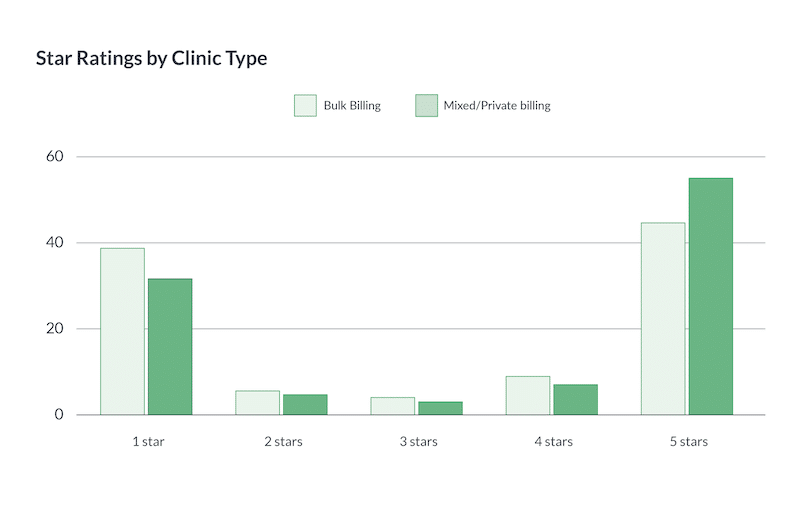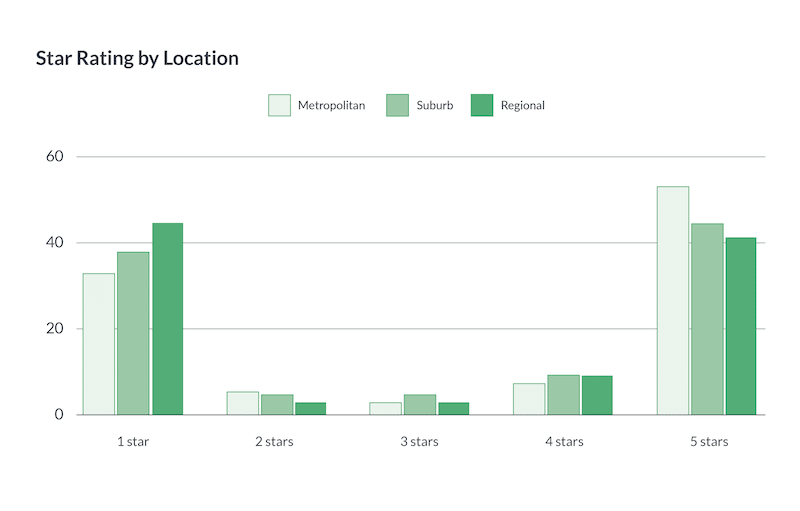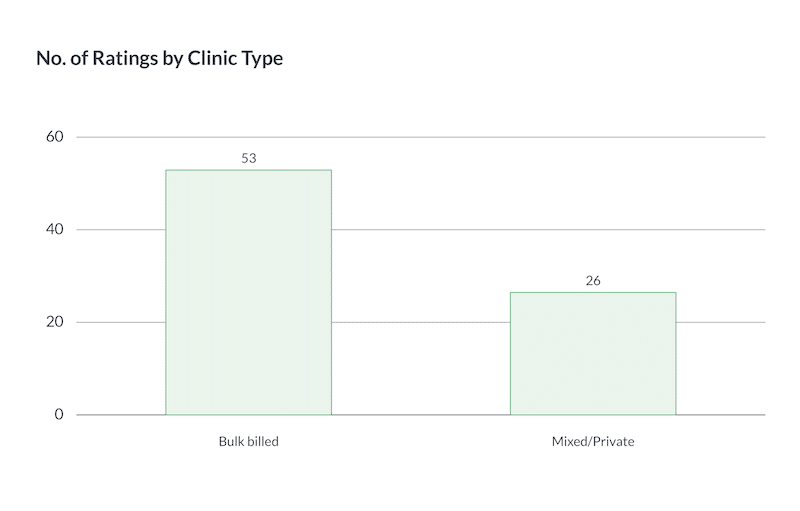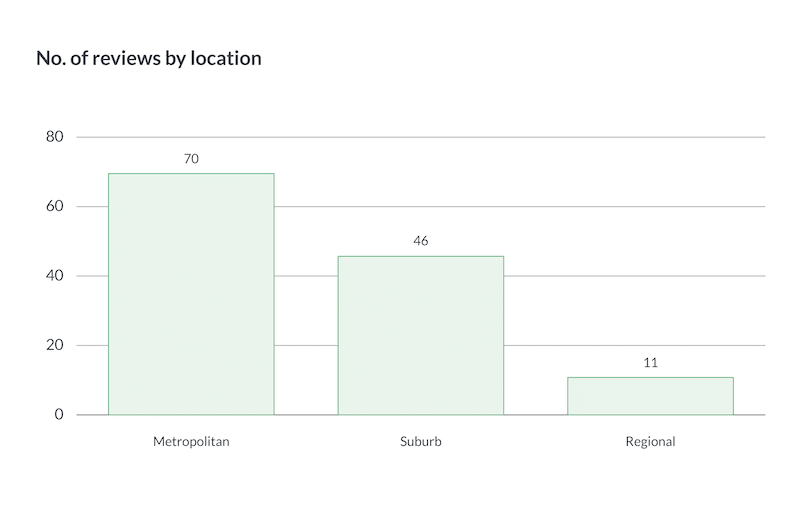Having a good Google Reviews rating is essential for any clinic looking to acquire new patients. According to one survey of 839 people in the United States, “74.6% of [US] people have looked online to find out about a doctor, a dentist, or medical care.” The same report found “69.9% of people [in the US] consider a positive online reputation to be very or extremely important.”
Even though the above stats are from the United States, I think we all know how important our online reputation has become. Think about the last time you yourself read online reviews to make a more informed choice.
But what is the benchmark separating a well performing clinic from a poor performing clinic? And how many reviews does the average clinic Australian have?
To investigate, we did a pulse check looking at the ratings medical centres received via Google in Australia. To do this, we analysed a small group of 61 medical centres from all over Australia. These medical centres were randomly selected and included 16 metro clinics, 23 suburban clinics and 22 regional clinics.
As well as looking at each clinic’s average star rating, and average number of reviews, we looked at the average number of 1 star, 2 star, 3 star, 4 star and 5 star reviews.
The average star rating is 3.63
In our sample, the average star rating for Australian clinics was 3.63.
In bulk billing clinics, the average star rating increased to 3.73, and in mixed/private clinics the average rating dropped slightly to 3.5.
For clinics in the suburbs, the average star rating was 3.74. In metro areas the average was 3.57 and in regional areas 3.45.
One and five-star reviews make up 85% of all reviews
Across all clinics, one and five-star reviews made up 85% of all reviews. This shows polarising patient experiences are overrepresented by Google Reviews. In other words, people tend to write reviews only when they have an extremely bad or extremely good experience.
The positive here is that patients are more likely to give you 5 stars than 1 star. Although, if you’re a bulk billing clinic this margin is a lot less.

For instance, in mixed/private billing clinics there is 24% higher chance a patient is going to write a 5 star review over a 1 star review. In bulk billing clinics, this drops to 6%, making it a toss of the coin whether a patient gives you 1 star or 5.
This same phenomena happens when you chart the results by location.

In a metropolitan clinic, it is 20% more likely a patient will give you a 5 star review over a 1 star review. In suburbs, this margin drops to 7%. And in regional areas, it drops even lower to around 3%. In fact, in regional clinics you’re 3% more likely to get a 1 star review than a 5 star review.
The real opportunity here is to increase the number of patients reviewing your clinic. If 1 in 10 patients left a Google review, rather than 1 in 1000, medical centres would have a much more representative sample.
Think about those patients who might not be wowed every time, but they’re loyal and satisfied. Those patients who make up the largest cohort of your patient base. If you encouraged more of them to review your clinic then you would start to drown out those infrequent 1 star reviews that add up over time.
Bulk billing clinics have twice as many reviews as mixed/private
Typically, bulk billing clinics have twice as many reviews as mixed/private billing clinics. While bulk billing clinics have 53 reviews on average, mixed/private clinics have just 26.

One read on this would be that bulk billing clinics typically see more patients (have higher throughput). More patients equals more reviews, right
Another reason could be that bulk billing patients tend to review things more often. Perhaps because they use reviews more often too. Maybe because they are more accustomed to comparing goods and shopping around.
It’s impossible to know exactly what’s causing this. The likelihood is that its a variety of factors. Nevertheless, it’s an interesting phenomenon. It means bulk billing clinics are more likely to show up first on Google Maps, because they tend to have more reviews and higher ratings (two metrics Google uses to rank clinics).
It also means that ratings and reviews are likely to have a bigger impact on the performance of bulk billing clinics.
For instance, if I was a patient comparing two mixed/private billing clinics, I am probably less likely to let the reviews impact my judgement because there are fewer of them. Whereas, if I was comparing two bulk billing clinics, maybe I’d take the reviews more seriously because there are more reviews to trust.
Metro clinics get 6 times as many reviews as regional clinics
Another interesting finding is that metropolitan clinics receive 6 times more reviews than regional clinics. Metro clinics have 70 reviews on average, while regional clinics have just 11.

One reason for this could be that people living in metropolitan areas tend to be more used to making reviews. Perhaps because they are more accustomed to reading more reviews too. Maybe being spoilt for choice, they have been forced into paying more attention to reviews?
Another thought here is that people in metro areas tend to be younger on the whole than people in regional areas. And young people tend to be the ones who leave the most Google reviews. The same US survey cited above found “30-44 are the most active age group when looking for providers (85.8%), checking reviews (65%), and posting a review (40.3%).”
A difference in 3 stars
Having a good Google Reviews rating is an extremely important component to running a successful clinic. Some clinics understand this and achieve almost 5 stars. The highest rated clinic in our list had 4.8 stars. Others neglect this fact entirely and barely make the high 1s. The lowest rated clinic on our list was 1.8 stars.
This 3 star difference between these two clinics is guaranteed to be having a big impact on the flourishing of one and the struggle of the other. The fact is, despite how much we wish it wasn’t true, most people who see a 1.8 star rating will immediately move on to the next clinic.
This is why solutions such as patient feedback are so important, because they provide an alternative avenue for patients to provide feedback. This reduces the number of disgruntled patients posting publicly, while also providing you with the feedback you need to improve the patient experience.
So, how does your clinic stack up? And what are you doing to improve your reputation?



